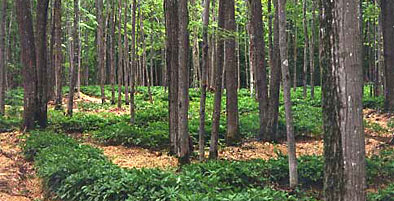Specialty forest mushrooms include such delicacies as shiitake, oyster, lion’s mane and wine cap which can be cultivated on wood substrates, as non-timber forest products for forest farming. Unfortunately, other choice wild edible mushrooms like chanterelles, morels, or boletus are not included because they cannot be deliberately cultivated. Shiitake is by far the most developed of the specialty forest mushrooms from the standpoint of both cultivation and marketing. There are four stages that the prospective grower must consider for forest cultivation of shiitake. Acquisition of substrate logs is the first one. What kinds of trees and when to cut them are the main considerations? Shortly after that comes inoculation of logs with the appropriate shiitake strain. The next stage requires some patience. The logs must be managed in a shady laying yard for up to a year to allow the fungus time to adequately colonize the log before it is ready to convert wood into mushrooms. After this so called “spawn run”, the focus shifts to fruiting, harvesting and marketing of the mushrooms. Well managed logs can be productive for 3 or more years.
